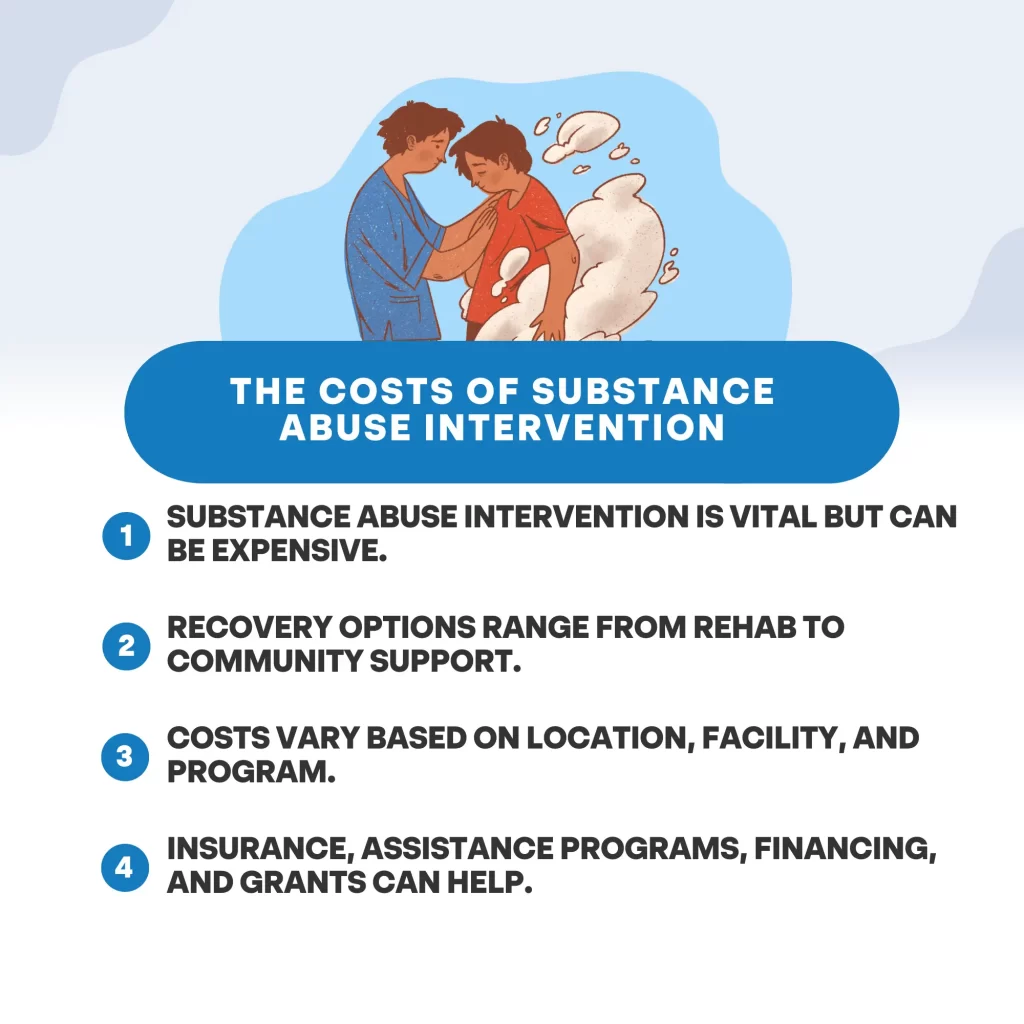

Table of Contents
When a person is caught in the grips of addiction, it affects not only their physical and mental well-being but also their financial stability. Seeking professional intervention and treatment is a crucial step towards recovery. Still, it can be accompanied by a hefty price tag. In this blog post, we will explore the costs of substance abuse intervention and provide insights into the expenses associated with various treatment options.
The Importance of Substance Abuse Intervention
Substance abuse intervention is the process of confronting an individual about their addiction and encouraging them to seek help. It can take various forms, including informal conversations with loved ones, formal meetings led by professional interventionists, or legal interventions. The primary goal is to help the person recognize the need for change and to guide them toward the most appropriate treatment option.
Interventions serve as a wake-up call for individuals struggling with addiction, often igniting a flicker of hope that leads them to accept the need for change. These timely and focused efforts can be the difference between life and death for someone caught in the throes of addiction.
While the decision to intervene can be challenging, the potential consequences of inaction often far outweigh the costs of substance abuse intervention. It’s important to remember that the ultimate goal of an intervention is to help the individual reclaim their life from the clutches of addiction, which can significantly impact their overall well-being and future financial prospects.
The Various Paths to Recovery
Substance abuse intervention is just the first step on the road to recovery. After accepting the need for change, individuals must choose a treatment path that aligns with their circumstances and recovery goals. The options can range from self-directed efforts to formal treatment programs offered by specialized facilities.
The cost of rehabilitation can vary significantly depending on the type and duration of the program. Inpatient rehab, which requires the person to reside at the treatment facility for a specific period, typically has higher costs than outpatient rehab, where the individual attends scheduled sessions while living at home. The expenses for inpatient rehab cover accommodation, meals, 24/7 medical care, therapy, and other amenities. In contrast, outpatient rehab primarily includes therapy and medication costs.
On the other hand, self-directed recovery efforts, such as attending support group meetings and therapy sessions, can be more affordable. Still, their success relies heavily on the individual’s commitment and ability to overcome challenges without intensive professional support.
The Less-Traveled Roads to Recovery
While the costs of substance abuse intervention and traditional rehab programs can vary, there are alternative paths to recovery that can be more cost-effective. However, they may not be suitable for everyone. These less-traveled routes include:
1. Telemedicine Programs
Telemedicine has revolutionized the healthcare industry, and it has also extended its reach to the addiction treatment field. These programs offer virtual therapy sessions and online support groups, providing individuals with access to professional help from the comfort of their homes. The cost of rehabilitation through telemedicine is significantly lower than traditional rehab, making it an attractive option for those with financial constraints or limited access to specialized facilities.
2. Sober Living Homes
Sober living homes are residential facilities that provide a structured and supportive environment for individuals in recovery. These homes act as a bridge between formal treatment and independent living, offering peer support, accountability, and resources to help residents maintain sobriety. The rehab cost in a sober living home typically includes rent, utilities, and sometimes additional services like counseling or employment assistance. While expenses can vary, they are generally more affordable than inpatient rehab.
3. Community-Based Support Programs
Numerous community-based support programs, such as 12-step fellowships, faith-based initiatives, and counseling services, offer assistance to individuals battling addiction. The cost of rehabilitation in these programs is minimal, often limited to nominal fees or voluntary donations. However, it’s important to note that the success of these support programs relies heavily on the individual’s dedication and active participation.
Factors Affecting the Cost of Substance Abuse Intervention
1. Location
The cost of rehab and intervention services can significantly differ depending on the treatment facility’s location. In areas with a high cost of living or in-demand addiction treatment centers, the expenses are likely to be higher than in less expensive or rural areas.
2. Treatment Facility Type
The rehab cost can also be influenced by the treatment facility’s type. Luxury rehab centers offering upscale amenities, such as spa services and private rooms, generally have higher prices than standard facilities.
3. Treatment Program Duration
The duration of the treatment program can impact the overall cost. More extended programs, such as those lasting 90 days or more, tend to have higher expenses than shorter-term options.
4. Treatment Program Features
The cost of rehab is also influenced by the treatment program’s features. Specialized programs targeting specific addictions or co-occurring mental health disorders may have higher prices due to the additional expertise and resources required.
Exploring Insurance Coverage and Other Financial Resources
1. Health Insurance
Health insurance coverage often includes benefits for substance abuse treatment, which can significantly reduce the cost of rehab. However, the extent of coverage can vary, so it’s crucial for individuals to review their insurance policies carefully and understand the terms and limitations.
2. Employee Assistance Programs
Many companies provide employee assistance programs that offer support and resources for addressing personal issues, including addiction. These programs may partially or fully cover the costs of substance abuse intervention and treatment, enabling individuals to seek help without incurring significant financial expenses.
3. Financing and Payment Plans
Some rehab centers and intervention service providers offer financing options and flexible payment plans to make treatment more affordable. These arrangements allow individuals to spread out the cost of rehab over time, reducing the financial burden.
4. Grants and Scholarships
In some instances, individuals may be eligible for grants or scholarships that can offset some or all of the costs of substance abuse intervention. Nonprofit organizations or specific treatment facilities typically offer these financial aid options.
The Bottom Line
Seeking professional intervention and choosing the most appropriate treatment path are significant decisions for individuals battling addiction. While the costs of substance abuse intervention can be substantial, the potential for long-term recovery and improved quality of life far outweigh the financial investment.
If you or someone you know is struggling with addiction, it’s essential to take the first step toward recovery by seeking professional help and support from a trusted treatment center or healthcare provider.
Choose Haven House Addiction Recovery for Compassionate and Effective Treatment
If you’re seeking addiction treatment in Clarksville or the surrounding areas, Haven House Addiction Recovery is here to help. Our experienced team is dedicated to guiding you or your loved one toward lasting recovery. Contact us today to learn more about our services.
Newsletter Signup
Discipleship Training
“The teaching of the wise is a Fountain of Life, turning a person from the snares of death.”
Proverbs 13:14 NIV



